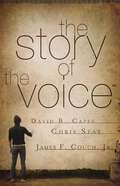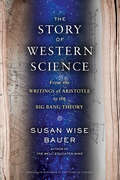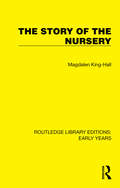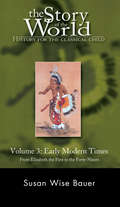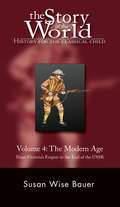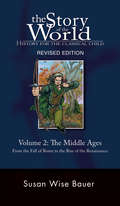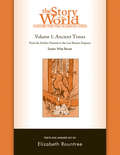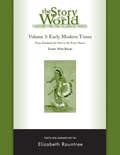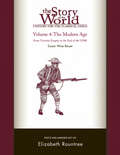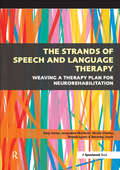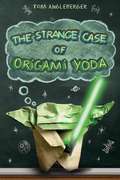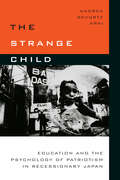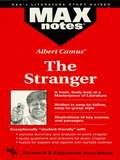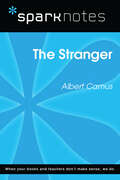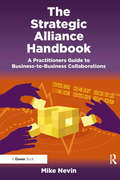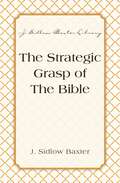- Table View
- List View
The Story of The Voice
by David Capes Jr.Step into the story behind "the story." Discover the reasons behind and the vision for The Voice translation! In-depth interviews with key participants explain the translators' motivations and visions for the project. Learn how the translators worked to bring a balance between scholarship, literary style, and forward thinking to meet the scripture needs for the church.Features include:Discussion of how The Voice makes the Bible accessible to new believersExplanation of The Voice's unique style and featuresExamples illustrate how scholars worked through the Hebrew and Greek texts of the BibleFirsthand accounts of The Voice translation project
The Story of Therese Neumann
by Albert Paul SchimbergOn Thursday night, March 4, 1926, in the town of Konnersreuth, Bavaria, a young peasant woman named Therese Neumann lay in bed, very weak and ill of what had been diagnosed as influenza. Suddenly she saw Christ in the Garden of Gethsemane.“I saw Him kneeling on the ground, and I saw everything else in the garden, the trees, the rocks and also the three disciples. All at once I felt such vehement pain in my side that I thought my last moment had come. Then I felt something running down my body. It was blood.”Thus did the stigmata come to Therese Neumann. Then in September, 1927, she began a total abstinence. From that time forward she neither ate nor drank. In the thirty-five years since 1927, the world has learned of this mystic and her ecstasies, of her stigmata and her total abstinence, through books and newspaper articles and the reports of visitors to Konnersreuth. Here is a summary account of her extraordinary life.
The Story of Western Science: From the Writings of Aristotle to the Big Bang Theory
by Susan Wise BauerA riveting road map to the development of modern scientific thought. In the tradition of her perennial bestseller The Well-Educated Mind, Susan Wise Bauer delivers an accessible, entertaining, and illuminating springboard into the scientific education you never had. Far too often, public discussion of science is carried out by journalists, voters, and politicians who have received their science secondhand. The Story of Western Science shows us the joy and importance of reading groundbreaking science writing for ourselves and guides us back to the masterpieces that have changed the way we think about our world, our cosmos, and ourselves. Able to be referenced individually, or read together as the narrative of Western scientific development, the book's twenty-eight succinct chapters lead readers from the first science texts by Hippocrates, Plato, and Aristotle through twentieth-century classics in biology, physics, and cosmology. The Story of Western Science illuminates everything from mankind's earliest inquiries to the butterfly effect, from the birth of the scientific method to the rise of earth science and the flowering of modern biology. Each chapter recommends one or more classic books and provides entertaining accounts of crucial contributions to science, vivid sketches of the scientist-writers, and clear explanations of the mechanics underlying each concept. The Story of Western Science reveals science to be a dramatic undertaking practiced by some of history's most memorable characters. It reminds us that scientific inquiry is a human pursuit--an essential, often deeply personal, sometimes flawed, frequently brilliant way of understanding the world. The Story of Western Science is an "entertaining and unique synthesis" (Times Higher Education), a "fluidly written" narrative that "celebrates the inexorable force of human curiosity" (Wall Street Journal), and a "bright, informative resource for readers seeking to understand science through the eyes of the men and women who shaped its history" (Kirkus). Previously published as The Story of Science.
The Story of the Avengers (Level 2)
by Marvel PressIn The Story of the Avengers, readers will learn how the Avengers first came together, forming a team of earth''s mightiest heroes!
The Story of the Nursery (Routledge Library Editions: Early Years)
by Magdalen King-HallOriginally published in 1958, this reconstruction of the lives of young children of nursery age is an excursion into the past, from the Middle Ages to the opening years of the twentieth century. It tells of the methods, often extraordinary to our ideas, by which they were brought up from babyhood to about seven years old, their clothes, diet, the fearsome remedies that were inflicted on them in illness, their toys, games, books and first steps in education. It shows how the pristine simplicity of the child’s nature, which hardly alters throughout the centuries, was moulded by the pressure of the adult society around them into some semblance of the accepted contemporary type. This story of the nursery is not only about young children, but about their parents too. There are parents in it who are stern, harsh, even cruel, and many more loving and careful ones; but one thing strikes us in these parents of former times: there is an air of unassailable confidence and certainty about them that the modern parent, versed in child psychology, would find it hard to achieve. As one seventeenth-century worthy put it, ‘For that which always happens in a concerne so universall as breeding children must needs be provided for by a traditionell method of proceeding.’
The Story of the Rockefeller Foundation
by Raymond B. FosdickSince its original publication in 1952, Fosdick's book has been the single most reliable treatment of one of the most important philanthropies in the United States and indeed the world. Fosdick served as president of the foundation for twelve years, from 1936 to 1948, when it was the largest grant-making endow-ment in the world. As Steven Wheatley notes in his valuable new introduction, in part The Story of the Rockefeller Foundation was intended as an instrument of institutional self-defense. When it was written, the foundation community was under mounting political attack from the right, and the book was meant to help balance the Scales by cataloging the foundation's good works. As a deliberate self-portrait, the book conceals as much as it reveals, while in the process it reveals a good deal about the author. Fosdick sees politics, like bureaucracy, as perhaps an avoidable problem and not an inevitable consequence of foundation activity. He sees foundations as engaging in the application of scientific, tech-nical, and organizational solutions to public problems through a ""venture cap-ital"" approach to discovering how to resolve them. Fosdick's ""higher ground"" approach became established philanthropic practice far beyond the Rockefeller Foundation. Consequently, this volume is significant as an institutional history as well as a charter for American foundations.
The Story of the World: From Elizabeth the First to the Forty-Niners (Vol. 3) (Story of the World)
by Susan Wise BauerThis third book in the four-volume narrative history series for elementary students will transform your study of history. The Story of the World has won awards from numerous homeschooling magazines and readers' polls--over 150,000 copies of the series in print! Now more than ever, other cultures are affecting our everyday lives--and our children need to learn about the other countries of the world and their history. Susan Wise Bauer has provided a captivating guide to the history of other lands. Written in an engaging, straightforward manner, The Story of the World: History for the Classical Child; Volume 3: Early Modern Times weaves world history into a story book format. Who was the Sun King? Why did the Luddites go around England smashing machines? And how did samurai become sumo wrestlers? The Story of the World covers the sweep of human history from ancient times until the present. Africa, China, Europe, the Americas--find out what happened all around the world in long-ago times. Designed as a read-aloud project for parents and children to share together, The Story of the World includes each continent and major people group. Volume 3: Early Modern Times is the third of a four volume series and covers the major historical events in the years 1600 to 1850, as well as including maps, illustrations, and tales from each culture. Each Story of the World volume provides a full year of history study when combined with the Activity Book, Audiobook, and Tests--each available separately to accompany each volume of The Story of the World Text Book. Volume 3 Grade Recommendation: Grades 3-8.
The Story of the World: From Victoria's Empire to the End of the USSR (Vol. 4) (Story of the World)
by Susan Wise BauerThis fourth book in the four-volume narrative history series for elementary students will transform your study of history. The Story of the World has won awards from numerous homeschooling magazines and readers' polls--over 150,000 copies of the series in print! Where was the Crystal Palace? Who was the Sick Man of Europe? And how did cow fat start a revolution? Now more than ever, other countries and customs affect our everyday lives--and our children need to learn about the people who live all around the world. Susan Wise Bauer has provided a captivating guide to the history of modern nations all around the world. Written in an engaging, straightforward manner, the final volume of the popular Story of the World series weaves world history into a storybook format, covering major historical events in the years 1850-2000. From the Middle East and China to Africa and the Americas--find out what happened all around the world in the last century and a half. Designed as a read-aloud project for parents and children to share together, The Story of the World includes the stories of each continent and people group. Each Story of the World volume provides a full year of history study when combined with the Activity Book, Audiobook, and Tests--each available separately to accompany each volume of The Story of the World Text Book. Volume 4 Grade Recommendation: Grades 3-8.
The Story of the World: From the Earliest Nomads to the Last Roman Emperor (Revised Second Edition) (Vol. 1) (Story of the World)
by Susan Wise BauerThis first book in the four-volume narrative history series for elementary students will transform your study of history. The Story of the World has won awards from numerous homeschooling magazines and readers' polls--over 150,000 copies of the series in print! What terrible secret was buried in Shi Huangdi's tomb? Did nomads like lizard stew? What happened to Anansi the Spider in the Village of the Plantains? And how did a six-year-old become the last emperor of Rome? Told in a straightforward, engaging style that has become Susan Wise Bauer's trademark, The Story of the World series covers the sweep of human history from ancient times until the present. Africa, China, Europe, the Americas--find out what happened all around the world in long-ago times. This first revised volume begins with the earliest nomads and ends with the last Roman emperor. Newly revised and updated, The Story of the World, Volume 1 includes maps, a new timeline, more illustrations, and additional parental aids. This read-aloud series is designed for parents to share with elementary-school children. Enjoy it together and introduce your child to the marvelous story of the world's civilizations. Each Story of the World volume provides a full year of history study when combined with the Activity Book, Audiobook, and Tests--each available separately to accompany each volume of The Story of the World Text Book. Volume 1 Grade Recommendation: Grades 1-5.
The Story of the World: From the Fall of Rome to the Rise of the Renaissance (Second Revised Edition) (Vol. 2) (Story of the World)
by Susan Wise BauerThis second book in the four-volume narrative history series for elementary students will transform your study of history. The Story of the World has won awards from numerous homeschooling magazines and readers' polls--over 150,000 copies of the series in print! Now more than ever, other cultures are affecting our everyday lives--and our children need to learn about the other countries of the world and their history. Susan Wise Bauer has provided a captivating guide to the history of other lands. Written in an engaging, straightforward manner, this revised edition of The Story of the World: History for the Classical Child, Volume 2: The Middle Ages weaves world history into a story book format. Who discovered chocolate? What happened to the giant Fovor of the Mighty Blows? Why did the Ottoman Turks drag their war ships across dry land? The Story of the World covers the sweep of human history from ancient times until the present. Africa, China, Europe, the Americas--find out what happened all around the world in long-ago times. Designed as a read-aloud project for parents and children to share together, The Story of the World includes each continent and major people group. Volume 2: The Middle Ages, is the second of a four-volume series and covers the major historical events in the years 400 to 1600 CE, as well as including maps, illustrations, and tales from each culture. Each Story of the World volume provides a full year of history study when combined with the Activity Book, Audiobook, and Tests--each available separately to accompany each volume of The Story of the World Text Book. Volume 2 Grade Recommendation: Grades 1-6.
The Story of the World: Tests and Answer Key (Vol. 1) (Story of the World)
by Susan Wise Bauer Elizabeth RountreeHistory has been taught in a boring way for far too long. A subject as moving and powerful as humanity's past should be inviting, and when it is told well, it is. Susan Wise Bauer succeeds in telling the captivating story of history with her best-selling history series. Parents and young readers have fallen in love with her narrative history, The Story of the World, and its accompanying Activity Book. Now teachers and home educators can take advantage of a new and valuable learning tool: the Tests and Answer Key package. Included are 42 tests: one for each chapter of The Story of the World. Perfect for evaluating comprehension and retention. The narrative format of The Story of the World helps children remember the famous people, places, and events in history. These tests offer you an easy way to make sure that your child is absorbing the important events from world history. A combination of multiple choice, matching, fill-in-the-blank, and short writing samples allow you to evaluate your child's retention and comprehension of key events in The Story of the World. The Tests package contains an answer key for all tests. These easy-to-use tests and answer keys, successfully used by hundreds of parents and teachers, provide an objective method for measuring retention of key facts, figures, and events from history. A combination of sequencing, matching, short-answer, and essay-style questions gives students a chance to show what they've learned. Used with The Story of the World Text Book and Activity Book (sold separately), the Test and Answer Key gives educators a complete history curriculum for their elementary school students.
The Story of the World: Tests and Answer Key (Vol. 2) (Story of the World)
by Susan Wise Bauer Elizabeth RountreeHistory has been taught in a boring way for far too long. A subject as moving and powerful as humanity's past should be inviting, and when it is told well, it is. Susan Wise Bauer succeeds in telling the captivating story of history with her best-selling history series. Parents and young readers have fallen in love with her narrative history, The Story of the World, and its accompanying Activity Book. Now teachers and home educators can take advantage of a new and valuable learning tool: the Tests and Answer Key package. Included are 42 tests: one for each chapter of The Story of the World. Perfect for evaluating comprehension and retention. The narrative format of The Story of the World helps children remember the famous people, places, and events in history. These tests offer you an easy way to make sure that your child is absorbing the important events from world history. A combination of multiple choice, matching, fill-in-the-blank, and short writing samples allow you to evaluate your child's retention and comprehension of key events in The Story of the World. The Tests package contains an answer key for all tests. These easy-to-use tests and answer keys, successfully used by hundreds of parents and teachers, provide an objective method for measuring retention of key facts, figures, and events from history. A combination of sequencing, matching, short-answer, and essay-style questions gives students a chance to show what they've learned. Used with The Story of the World Text Book and Activity Book (sold separately), the Test and Answer Key gives educators a complete history curriculum for their elementary school students.
The Story of the World: Tests and Answer Key (Vol. 3) (Story of the World)
by Susan Wise Bauer Elizabeth RountreeHistory has been taught in a boring way for far too long. A subject as moving and powerful as humanity's past should be inviting, and when it is told well, it is. Susan Wise Bauer succeeds in telling the captivating story of history with her best-selling history series. Parents and young readers have fallen in love with her narrative history, The Story of the World, and its accompanying Activity Book. Now teachers and home educators can take advantage of a new and valuable learning tool: the Tests and Answer Key package. Included are 42 tests: one for each chapter of The Story of the World. Perfect for evaluating comprehension and retention. The narrative format of The Story of the World helps children remember the famous people, places, and events in history. These tests offer you an easy way to make sure that your child is absorbing the important events from world history. A combination of multiple choice, matching, fill-in-the-blank, and short writing samples allow you to evaluate your child's retention and comprehension of key events in The Story of the World. The Tests package contains an answer key for all tests. These easy-to-use tests and answer keys, successfully used by hundreds of parents and teachers, provide an objective method for measuring retention of key facts, figures, and events from history. A combination of sequencing, matching, short-answer, and essay-style questions gives students a chance to show what they've learned. Used with The Story of the World Text Book and Activity Book (sold separately), the Test and Answer Key gives educators a complete history curriculum for their elementary school students.
The Story of the World: Tests and Answer Key (Vol. 4) (Story of the World)
by Susan Wise Bauer Elizabeth RountreeHistory has been taught in a boring way for far too long. A subject as moving and powerful as humanity's past should be inviting, and when it is told well, it is. Susan Wise Bauer succeeds in telling the captivating story of history with her best-selling history series. Parents and young readers have fallen in love with her narrative history, The Story of the World, and its accompanying Activity Book. Now teachers and home educators can take advantage of a new and valuable learning tool: the Tests and Answer Key package. Included are 42 tests: one for each chapter of The Story of the World. Perfect for evaluating comprehension and retention. The narrative format of The Story of the World helps children remember the famous people, places, and events in history. These tests offer you an easy way to make sure that your child is absorbing the important events from world history. A combination of multiple choice, matching, fill-in-the-blank, and short writing samples allow you to evaluate your child's retention and comprehension of key events in The Story of the World. The Tests package contains an answer key for all tests. These easy-to-use tests and answer keys, successfully used by hundreds of parents and teachers, provide an objective method for measuring retention of key facts, figures, and events from history. A combination of sequencing, matching, short-answer, and essay-style questions gives students a chance to show what they've learned. Used with The Story of the World Text Book and Activity Book (sold separately), the Test and Answer Key gives educators a complete history curriculum for their elementary school students.
The Story of the World: The Middle Ages, From the Fall of Rome to the Rise of the Renaissance (Revised Edition)
by Susan Wise Bauer"The Story of the World" covers the sweep of human history from ancient times until the present. Africa, China, Europe, the Americas--find out what happened all around the world in long-ago times. Designed as a read-aloud project for parents and children to share together, "Volume 2: The Middle Ages," is the second of a four-volume series and covers the major historical events in the years 400 to 1600 CE, as well as including maps, illustrations, and tales from each culture.
The Straight Talk on Parenting: A No-Nonsense Approach on How to Grow a Grown-Up
by Vicki HoefleParents these days are under a great deal of pressure to be "perfect." From psychologists to social scientists, journalists to weekend bloggers, everyone has an opinion about the do's and don'ts for raising healthy, well-adjusted--and let's not forget, polite--children in today's fast-paced world. Where does this leave parents? Too often, lacking in confidence, ill equipped, and overwhelmed. Parenting expert Vicki Hoefle makes the bold claim that it's time for parents to get off the perfection path and get back to the real job of parenting: to grow a grown-up. In this no-nonsense parenting guide, Hoefle draws upon twenty-five years of experience with helping parents see the big picture and sidestep what she calls the "detail drama" that too often trumps everyday life with our kids. Parents learn more than just strategies; they learn a methodology that allows them to help their toddlers build a strong foundation for success in adulthood.In her trademark, tell-it-like-it-is style, Hoefle tells parents to trust their intuition and develop an intentional strategy for meeting each child's unique needs. Above all, The Straight Talk on Parenting offers the confidence-boosting reminder that parenting is about practice (and a healthy dose of humor), not perfection.
The Strands of Speech and Language Therapy: Weaving Plan for Neurorehabilitation
by Katy JamesThis book is written by a team of speech and language therapists from The Wolfson Neurorehabilitation Centre. It is intended for practitioners working with patients who have acquired communication disorders resulting from brain injury: aphasia, cognitive-communication disorder, dysarthria, apraxia. The authors believe that a therapeutic programme should have it's foundations in the linguistic, non-verbal, neurological and neurospsychological perspective of the patient's difficulties. The approach the team has developed consists of several different strangs of therapy, with each strand representing an element of the rehabilitation process: assessment; goal planning; specific individualised treatment; education; friends and family; and psychosocial adjustment. This book describes these strands, illustrates in a user-friendly way how each one relates to therapy, and fives some practical ideas of how practitioners might work within them. Each chapter begins with the guiding principles and evidence bases that underlie the rationale for one particular strand of therapy. They then follow examples of practice and case studies of a real-life example of each strand. This book describes a speech and language therapy service that aims to be responsive to patients' needs and develops tailor-made intervention programmes that arer unique to each individual. It includes CD containing assessments and practical tools.
The Strange Case Of Origami Yoda (Origami Yoda Ser. #1)
by Tom AnglebergerSixth-grader Tommy and his friends describe their interactions with a paper finger puppet of Yoda, worn by their weird classmate Dwight, as they try to figure out whether or not the puppet can really predict the future. Includes instructions for making Origami Yoda.
The Strange Case of Origami Yoda
by Tom AnglebergerIn this funny, uncannily wise portrait of the dynamics of a sixth-grade class and of the greatness that sometimes comes in unlikely packages, Dwight, a loser, talks to his classmates via an origami finger puppet of Yoda. If that weren't strange enough, the puppet is uncannily wise and prescient. Origami Yoda predicts the date of a pop quiz, guesses who stole the classroom Shakespeare bust, and saves a classmate from popularity-crushing embarrassment with some well-timed advice. Dwight's classmate Tommy wonders how Yoda can be so smart when Dwight himself is so clueless. With contributions from his puzzled classmates, he assembles the case file that forms this novel.
The Strange Child: Education and the Psychology of Patriotism in Recessionary Japan
by Andrea Gevurtz AraiThe Strange Child examines how the Japanese financial crisis of the 1990s gave rise to "the child problem," a powerful discourse of social anxiety that refocused concerns about precarious economic futures and shifting ideologies of national identity onto the young. Andrea Arai's ethnography details the different forms of social and cultural dislocation that erupted in Japan starting in the late 1990s. Arai reveals the effects of shifting educational practices; increased privatization of social services; recessionary vocabulary of self-development and independence; and the neoliberalization of patriotism. Arai argues that the child problem and the social unease out of which it emerged provided a rationale for reimagining governance in education, liberalizing the job market, and a new role for psychology in the overturning of national-cultural ideologies. The Strange Child uncovers the state of nationalism in contemporary Japan, the politics of distraction around the child, and the altered life conditions of--and alternatives created by--the recessionary generation.
The Stranger (MAXNotes Literature Study Guides)
by Kevin KellyREA's MAXnotes for Albert Camus' The Stranger MAXnotes offer a fresh look at masterpieces of literature, presented in a lively and interesting fashion. Written by literary experts who currently teach the subject, MAXnotes will enhance your understanding and enjoyment of the work. MAXnotes are designed to stimulate independent thought about the literary work by raising various issues and thought-provoking ideas and questions. MAXnotes cover the essentials of what one should know about each work, including an overall summary, character lists, an explanation and discussion of the plot, the work's historical context, illustrations to convey the mood of the work, and a biography of the author. Each section of the work is individually summarized and analyzed, and has study questions and answers.
The Stranger (SparkNotes Literature Guide Series)
by SparkNotesThe Stranger (SparkNotes Literature Guide) by Albert Camus Making the reading experience fun! Created by Harvard students for students everywhere, SparkNotes is a new breed of study guide: smarter, better, faster. Geared to what today's students need to know, SparkNotes provide: *Chapter-by-chapter analysis *Explanations of key themes, motifs, and symbols *A review quiz and essay topics Lively and accessible, these guides are perfect for late-night studying and writing papers
The Strategic Alliance Handbook: A Practitioners Guide to Business-to-Business Collaborations
by Mike NevinStrategic alliances offer organisations an alternative to organic growth or acquisition when faced with the need to develop the business to a new level, innovate in terms of products or services or significantly reduce costs. The Strategic Alliance Handbook is a clear and complete guide to the nuts and bolts of the process behind successful collaborations. The book enables readers to understand the commercial, technical, strategic, cultural and operational logic behind any alliance and to establish an approach that is appropriate for the type of alliance they are seeking and the partner organisation(s) with whom they are working. Whether you are an alliance executive, responsible for the systems, strategy and performance of your organisation's alliancing programme or an alliance manager needing to ensure the success of a given partnership, The Strategic Alliance Handbook is an essential guide.
The Strategic Grant-seeker: A Guide To Conceptualizing Fundable Research in the Brain and Behavioral Sciences
by Judy IllesAn understanding of each of the critical components of the funding process is key to meeting the challenges posed by the increasingly intense competition for research funds. This book is a vital tool for those who want to build and maximize their grant support. Although many publications provide valuable information about proposal preparation, few cover the full spectrum of issues--from planning through execution--in the funding process. The book leads off with a discussion of the relationship between researchers and the funding environment, features of good short- and long-range funding plans, characteristics of funding organizations in terms of funding power, mission, and priorities, and the manner in which funding information is disseminated. Succeeding chapters focus on the actual development of the many different types of opportunities--research projects, multicomponent research programs, career development and training programs, and small business innovation research. These chapters emphasize conceptualizing an idea, optimizing the researcher-sponsor match, and testing the concept for competitiveness. Further chapters deliver strategies for translating research ideas into written proposals, preparing administrative sections and communicating with a sponsor. The final chapters are dedicated to the outcomes of the proposal process: reviews, rebuttals, and resubmissions; and to progress reports and future proposals for maintaining and building on funding. Flowcharts, examples, and summary tables are used throughout the text to highlight key points.
The Strategic Grasp Of The Bible (J. Sidlow Baxter Library)
by J. Sidlow BaxterWithin the compass of this substantial volume, a major study work, Dr. J. Sidlow Baxter points out the marvel of the structural design of the Scriptures. First examining the “architecture” of the Bible, he suggests the basic approach to, and expectation of what is to be gained by the study of Scriptures. He then makes clear how a certain fitness for delineating the spiritual truths of the Bible may be acquired - and so he leads the reader to understand the structure of the Bible as a whole. In the second part of his book, Dr. Baxter points to the two dispensations defined in John 1:17 and offers stimulating comparisons between the Old and New Testaments. Further chapters lead toward a clear understanding of the Kingdom of Heaven, the Church, and the entire New Testament. Included in the text are useful outlines and tables to summarize key factors, figures, pronouncements and turning points which have pivotal or crucial significance in the total message of the Bible.
